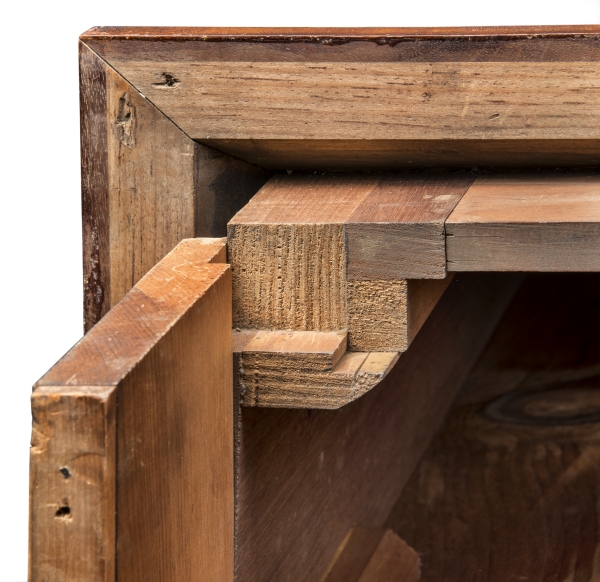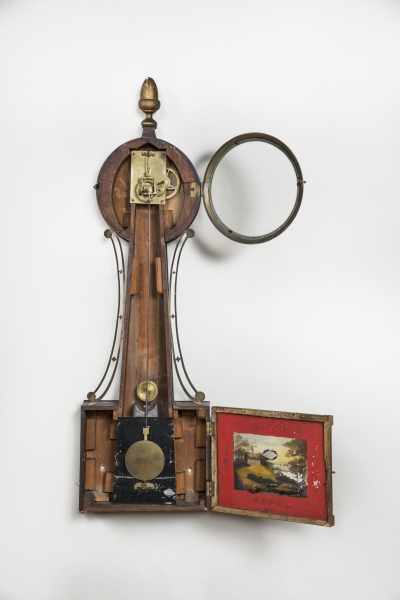· 12 ·
“The Best Workman in the Shop”:
Cabinetmaker William Munroe of Concord
DAVID F. WOOD
In generalizing the structure of the eighteenth-century cabinetmaking shop, I find it useful to borrow two terms from the biologist Humberto Maturana: allopoietic and autopoietic.1 Allopoietic describes a system that produces something other than itself; autopoietic describes a system that produces itself. The cabinetmaking shop is both: allopoietic in that it produces furniture, and autopoietic in that it trains apprentices. Sometimes the apprentice stays in the shop to be a journeyman for a while; sometimes, especially among kin, the apprentice assumes command of the shop. More often, they move on to another shop or found their own. Boston furnituremaking shops, particularly in the vigorously productive late eighteenth century, become in this view metashops, ones that are demonstrably both allopoietic and autopoietic.
Much of the work in material culture history is concerned with the allopoietic side of the coin. Connoisseurship, for instance, focuses on the stuff that shops produce. How is the drawer constructed? What does the carving look like? The literature is replete with attributions and reattributions of specific objects to specific shops, and from this the regional cultural maps follow—Boston, Newport, Philadelphia, Portsmouth, southeastern Massachusetts, southeastern Pennsylvania. William Munroe (1778–1861) provides us with a rare entrée into the autopoietic realm through a remarkable autobiography written in 1839, when he was sixty-one years of age.
Munroe’s autobiography is some twenty thousand words long, and though by his own admission he was indifferently educated, it is legible, articulate, and almost entirely free of cliché, polemic, or rhetorical devices. Even his occasional ad hominem attacks are generally even-handed. He wrote of expectations, disappointments, motivations, and satisfactions candidly and honestly. From his account, it can be seen that his course was guided by factors that include international politics, fashion, self-esteem, and good food.2
The autobiography survives along with numerous records from Munroe’s shop, including five account books that document the entire span of his working career, from 1800 to 1842 (fig. 1). This material, together with a group of objects by or attributed to William Munroe, allows for a chronological consideration of Munroe’s training and career as a cabinetmaker in Boston and Concord between 1792 and 1819. Also documented in his narrative, account books, and surviving objects is the transition Munroe made from cabinetmaking to pencilmaking, partially from 1812 to 1816, and completely after 1819.
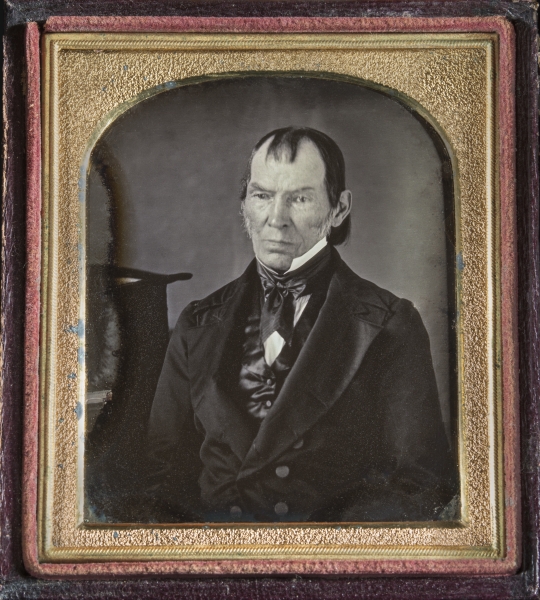
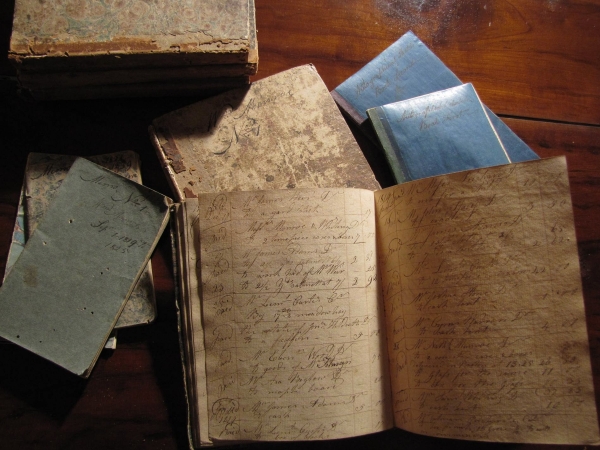
FIG. 1. Autobiography, account books, and receipt books of William Munroe (1778–1861). Concord Museum; Gift of Bill and Charlie Munroe, 2009. Daguerreotype of William Munroe, Boston, ca. 1845. Daguerreotype; h 3½, w 2¼. Concord Free Public Library, William Munroe Special Collections; Gift of Martha Cole.
William Munroe was born in Roxbury in 1778. Part of the fifth generation of his family in America, Munroe was the grandson of a patriot killed in Lexington on April 19, 1775, the grandson of another patriot who participated in the Boston Tea Party, and the son of a trader in West Indies goods. He grew up in a house that his father, Daniel, owned on Roxbury Street in the heart of the busy web of craft shops that characterized federal-era Roxbury.3
But busy as it was as a manufacturing center, Roxbury in the 1790s retained a rural aspect (fig. 2). William’s grandfather Jonathan Parker—the Tea Party participant—had a dairy farm and orchard that his grandson remembered fondly for its fresh apples and whitpot (a type of pudding), baked apples, and milk. In 1792, at age thirteen, William was placed by his father to assist on the farm: “But being not very strong, nor liking to work hard on a farm, I complained to my father, and was thereupon asked by him which I had rather do, work on the farm, or return home & go to school.”4 William stayed on the farm for the season and afterward “attended school but with indifferent progress.” Munroe described his education as being “of a very limited character,” consisting only of arithmetic and common handwriting. He was uneasy in school, in part, he believed, because his absences made him a perpetual stranger in class.
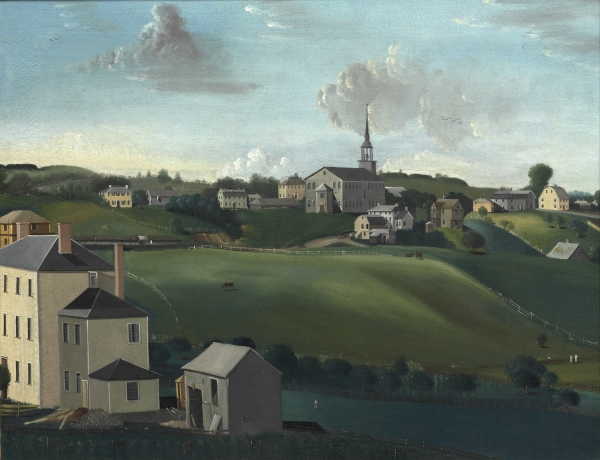
FIG. 2. Meetinghouse Hill, Roxbury, Massachusetts, John Ritto Penniman (1782–1841), Boston, 1799. Oil on canvas; h 29, w 37. Art Institute of Chicago; Centennial Year Acquisition and Centennial Year Major Acquisition funds (1979.1461).
“When about 14 years old my father put me as an apprentice with a Mr Mills, a Wheelwright by trade in Roxbury street.” The business was “not well suited to my inclination or my strength,” Munroe wrote, again citing his overall constitution as a factor in choosing a trade. After about five months he “went home sick and did not return,” having cut a tendon in the middle finger of his left hand, which left him unable to move one joint. Munroe had one other cause for complaint: “We had for six days in a week mush, salt fish & potatoes for dinner & nothing else.”
“After I had recovered my health, I was carried by my father to Dorchester to be an apprentice at the cabinet business, to a Major Stephen Badlam, Esqr. I was now about fifteen years old and recollect having an ambition to learn the cabinet business, which at the time was profitable & desirable.” Though brief, this matter-of-fact statement is informative. William was “carried by” his father, so Daniel Munroe was apparently still responsible for placing his son in a position, even after two false starts. But the fifteen-year-old William’s own wishes were also a consideration; it was he who wanted to learn cabinetmaking, and he had two reasons he thought good, in retrospect. The first is perhaps self-explanatory; there was money to be made. For the second, Munroe does not indicate what, beyond profit, made cabinetmaking “desirable.” However, his narrative contains some hints of what he may have meant, as well as unequivocal evidence that he used the phrase “at the time” advisedly.
Stephen Badlam “kept quite a number of hands, & had a good shop.”5 Unfortunately, William soon came to be “under a strong conviction that I should not acquire the trade at that place.” Apprentices “as a general rule at this shop, were employed about two years at helping saw veneers, turning a large lathe wheel, & at farming.” Badlam’s furniture displays a good use of highly figured veneers, as can be seen in a group of eight-day clock cases by or attributed to the shop.6 Unfortunately, sawing out veneers and turning a wheel to power a lathe are endless, repetitive tasks, and there is nothing to be learned by continuing the exercise. Here is grim evidence in support of the fact that power tools in the modern cabinet shop take the place of the apprentice. What’s more, at Badlam’s shop, Munroe was back to square one; working as a boy on a farm. The clincher, though, may have been the same problem as at Mill’s shop: “apprentices were kept very meanly as to food.” After nearly a year in Stephen Badlam’s shop, Munroe “returned home by leave of my father, but without leave of absence from Mr. Badlam.”7
One of the more interesting things Munroe had to say about Badlam was that he “did not work at the business himself.” Here, then, is a good shop with a number of hands, headed by a man who spends no time at the bench. That Munroe notes this fact suggests it was a little out of the ordinary, but it was not a unique circumstance and was, in fact, the sort of detached relationship to the shop that Munroe sought for himself for most of his career.
“After I had remained at home a short time, I was placed by my father as an apprentice to a Mr John Paddleford, a Cabinet maker in Roxbury street.” Munroe reported that Padelford (as his name is spelled on the only piece attributed to him) was “a good workman,” and he trained in the shop during 1795 and 1796, until he could “make a good mahogany desk, which were at that time in high fashion.” But when Padelford resolved to relocate to Taunton, in southeastern Massachusetts, Munroe, despite being offered a $100 bounty to be paid when he was free, did not accompany him.
This time, the motivation was something other than food. Munroe’s father was concerned he “might not get the trade perfectly by moving into the country.” But William had “determined not to go.” Padelford “was more given to politics than work, took snuff to excess and was not in very good circumstances as to property.” Moreover, Munroe’s decision “was partly owing to a Brother in law of his [that is, of Padelford’s] who was also an apprentice to him, and who being a little older than myself, and also possessed of some property, made him feel very large, & assume power to domineer over & insult me with impunity. I was therefore gratifyed that I was likely to be released from his companionship.”
Padelford’s departure from Roxbury was accompanied by a bit of drama involving the seventeen-year-old Munroe, who reported: “At the time of Paddleford’s leaving Roxbury, he owed me about three dollars. I had asked him for it repeatedly, and when he had got into the stage to leave for Taunton I had not got it. Before the stage had started, I informed my father that he must go and dun Paddleford for my three dollars. Father was moved at my request, & at my tears, and he immediately went to the stage & told him that he must pay me the small demand he owed me, and I therefore got my pay. I have never seen Mr. Paddleford since. He was a good hearted man but not a very good husband and I should never probably have got my 100$ if I had gone with him.” Lending some credence to Munroe’s slighting assessment of John Padelford’s husbandry is the fact that his output is represented by only a single object, a signed desk and bookcase dated 1806.8
Although they were all open to him, Munroe rejected the paths of scholar, farmer, and wheelwright before determining at age fifteen to become a cabinetmaker, only to leave one shop because he felt the training there would be inadequate and, in a sense, have another shop leave him. Munroe’s experience raises some interesting questions, although there are too few comparable narratives to answer them. Was every cabinetmaking apprentice so peripatetic in federal Boston? Or perhaps only those who showed unusual promise or who had particularly supportive parents?
Munroe certainly had both promise and support. After Padelford left, “an arrangement had been made by my father with Deacon Nehemiah Munroe a cabinet maker in Roxbury street for me to be an apprentice to him and it was said at the time that Paddleford recd a sum from the Deacon as a remuneration for giving up so good an apprentice, and also so good a workman as he represented me to be. Let this be as it may.” Munroe had found a place to complete his training: “I remained at this place as an apprentice until I was twenty one years old.”
Although he doesn’t mention the relation, the deacon was his second cousin once removed. Born in Lexington in 1747, Nehemiah Munroe died in Roxbury in 1828, leaving an estate valued in excess of $22,000.9 William Munroe entered Nehemiah Munroe’s shop in 1796 and “was very soon an inmate in his shop with quite a number, including journey men & apprentices.” Nehemiah Munroe was in partnership with a former apprentice of his, John Clap, doing business as Munroe & Clap.10 Clap was “the chief director of the business & overseer of all the hands. The Deacon not being an operator excepting the procuring of stock and supply’s necessary for the shop and other out door concerns.”
Here again, as in Badlam’s shop, the principal does not work at the bench.11 However, Nehemiah did share responsibility for training a new generation of craftsmen: “The Deacon had the largest half of the hands, and my being one of his apprentices, was a fellow apprentice with four others, Lemuel Churchill, Ephrahim Capen, William Viles, and Daniel Pierce.”
The allopoietic function of the Munroe and Clap shop can only be inferred; although it was a busy and profitable firm, no objects can presently be assigned to the shop on the basis of documentary evidence. The autopoietic function, however, is well documented. Of five apprentices in the shop in 1796, all completed their training and worked professionally in the trade. Two—Lemuel Churchill and William Munroe—established their own shops, and a third, William Viles, may have also headed his own shop. Churchill was born in 1775 and was a journeyman with William Fisk in 1799. Viles was born in 1779, was a journeyman with William Fisk, and sold furniture through John Doggett. Daniel Pierce was also born in 1779 and was associated at one point with the cabinet shop of William Leverett, apparently as a journeyman. Ephraim Capen seems to have completed his training and worked as a journeyman for Munroe and Clap.12
The autopoietic function of the Munroe and Clap shop intersected with the domestic function of Nehemiah Munroe’s home at several points. As is often the case with intersections, this entailed some friction:
I had been there about a year, when it so happened that the coat I wore daily had become quite dilapidated, and in leaving it off to be repaired, I had put on my best. This of itself would seem to be but a very small crime, but owing to the apprentices not being allowed to have their stints where by they might gain a little time for themselves, as was customary among others of the same occupation they became in some measure cross and refractory, and had by some means express’d it to the Deacon and which had made him as well as them, in a not very pleasant mood towards each other. In this state of things the Deacon came into the shop, and finding me to work with my best coat on, he immediately took fire. I endeavoured to reason with him on the necessity of my having my old coat mended, and of wearing my best one untill it could be done but he would not hear to my reasoning, & considered it as meant to insult either him or the females in the house, whose duty it was to keep the apprentices clothes in decent repair, and finally told me he had nothing further for me to do.
Early indentures for apprentices sometimes make provision for clothing, but the more formal arrangements evident in surviving contracts and suggested by advertisements concerning runaway apprentices seem to have eroded by the 1790s. Nevertheless, as William Munroe informs us, that aspect of apprenticeship had persisted, and the women in Deacon Munroe’s household were responsible for the clothing of his apprentices.13 This passage also reveals that it was customary—and Munroe could only cite custom, not a contract—for Boston cabinetmaking shops to arrange the assigned duties of the apprentices in such a way that they had some time for themselves, time they could presumably turn to profit. Moreover, the episode suggests what may be one reason Munroe considered cabinetmaking desirable as well as profitable: it was a “white-collar” occupation. The apprentices at work dressed more like gentlemen than like laborers.
Once again, William Munroe’s father helped his son negotiate a difficulty in his apprenticeship: “I therefore left the shop & went home to my fathers. I stated the case to him and he thought it best to go immediately to see the Deacon, and to take me with him. After a short consultation in which I endeavoured to justify myself, I was reinstated and continued through my time.” His time was “[n]ot however perfectly free from other altercations and difficulties in connection with the other apprentices.” Two of these subsequent squabbles involved another intersection of shop and home: food.
It had been the custom from time almost immemorial for two tables to be set for dinner,—one for the Deacons family and the other for the apprentices. Both sit down to their respective tables at the same time, all the food however was on the family table. It was there carved & when ready, the Deacon would call out “hand your plates.” (The kitchen was long & narrow, and the tables were about ten feet apart.) The eldest apprentice carried his plate first, then the next oldest and so on to the last. This had always been a subject of grievance, and when I was about nineteen years old [1797] we all agreed to break up the practice, or leave the shop. What brought the subject up to this desperate point was: the Deacon had a job of mason work done, and was performed by an apprentice to a mason in the neighborhood, and was one of our intimate friends & associates. This young man sit at the Deacons table; and in his presence we had to carry up our plates to have them filled. We all felt mortified as well we might, and had been many times before, and now for the first time the subject was proposed to break it up or suffer the consequences.
The eldest apprentice, Ephrahim Capen, “Lemuel Churchill having come of age a few months before,” was delegated to inform Deacon Munroe of their resolve, with the result that “we afterwards had our table in the same room, while the Deacons family dined at the same time in the sitting room; a duty now devolved on the youngest apprentice which was to fetch out a dish of the food from the Deacons table & which was carved up and always good & enough.” Dinner was the main meal of the day, but “[b]read and milk was our daily food, both morning & night through the year, excepting on Sabbath mornings, when we had chocolate. We thought that chocolate was none too good to have for every day’s food, and we gave out word that we must have it, but not in so formal a manner as in the alteration for dinner.” This demand was also granted.
The difficulty was not with the food: “It is but justice to remark that whatever we did have was always of good quality and enough,” Munroe reiterated. The tension seems to have had more to do with self-esteem. The boys felt humiliated, “as well we might,” that a peer sat with the family while they had to enact a small ritual of abnegation to get their food. It probably didn’t help that the apprentice mason seems to have been granted by his shop the free time denied the Deacon Munroe’s apprentices. Chocolate was “none too good” for the “resolved and determined characters” in the shop, and although Munroe is poking a little fun at his younger self and companions over the chocolate, the stakes were nevertheless high: “we had formed our resolution and meant to succeed or leave.” On two separate occasions, the apprentices resolved to get their way or leave the shop en masse. On both occasions, Deacon Munroe and the women of his household acceded to their demands. Advantage, apprentices, but why? Was there so much demand for labor in Roxbury in 1796, or was this particular band so exceptionally skilled that they could have walked into another shop (presumably without references) and resumed their training?
In any event, the rupture did not come to pass, and “we thus lived until I was of age & free. During my apprenticeship I had become the best workman in the shop. All extra work that required nicety, carved work or any new fashion that had not been made in the shop before was committed to me.” A miniature sideboard in the Winterthur collection lends credence to Munroe’s boast (fig. 3). The workmanship is jewel-like and precise. The proportions agree closely with a contemporary full-size sideboard of the same overall design.14 Although miniature furniture is often challenging to interpret, this is no toy. It is difficult to believe it is anything other than an essay meant to demonstrate mastery of skills, and it would perhaps have been executed in Deacon Munroe’s shop during whatever time William Munroe had to himself. The sideboard does indeed reflect the skills William had gained in his training, but it seems to have been made five years after he completed the apprenticeship, as a gift to his new bride.15
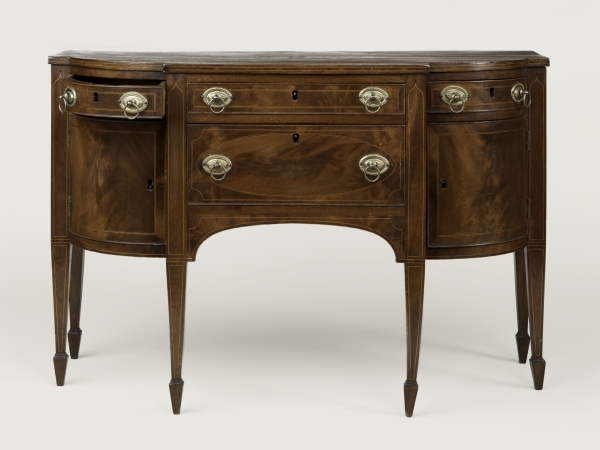
FIG. 3. Miniature sideboard, attributed to William Munroe, Concord, Mass., 1795–1810. Mahogany, white pine, holly, ebony; h 13⅞, w 21, d 9. Winterthur Museum; Gift of Henry Francis du Pont (1959.0995).
Despite the considerable skill evident in the miniature sideboard, William Munroe’s future was anything but sure: “Yet now, although a freeman and esteemed a good workman, I felt as if thrown upon an ungrateful and unfeeling world and subject to all its ills.” The year was now 1799; if, in 1796, the apprentices had been confident enough of their prospects to strike over chocolate, Munroe’s view of the situation just three years later would suggest they had been mistaken. “I was however immediately employed as a journeyman in the same establishment, and continued to make the best of the furniture; I remained however but a little over five months . . .”
William Munroe, in his autobiography and in the first of his account books, the earliest entry of which is dated December 21, 1799, itemized the furniture he made in those five months: four sideboards at $21 each, two fire screens at $3 each, two card tables at $4.67 each, ten mahogany chairs at $2 each, and six more elegant chairs at $3 each. The charges are for his labor alone; materials are not included. The sideboards are described in the account book as sash-cornered, a term that applies to the shape of the miniature sideboard. The card tables are also described as sash-cornered, and the $3 chairs are described as sash-cornered, “newest fation’d,” with carved ribs.16
Munroe’s tenure as a journeyman in the deacon’s shop ended in May 1800, “when my Brother Daniel was desirous & strongly urged me to come to Concord to make handsome mahogany clock cases for him, he having sett up the clock making business in that town.” From January 15, when he noted a charge “to making a sideboard,” to May 26, 1800, when he settled accounts with Munroe and Clap, William had earned $137 but “the price of my board had to come out of it, & left me not far from a hundred dollars.”
The amount of work Munroe did in five months is impressive; it is difficult to believe he could have done much more. His projected net income as a journeyman, then, was about $300 a year or a little less, not much more than a common laborer could make if constantly employed. But the clockmaking trade was “then profitable, and clocks then fashionable,” and William accepted his brother’s offer.
“I thus left Deacon Munroes shop, spent some time in collecting togethear such tools, patterns etc. as was necessary for the purpose of making clock cases, spent about all I had earned for this purpose.” William did not get away without one further humiliation: “I had commenced another job of making eight very handsome chairs. I had worked very hard, two days upon them, and had gotten the stuff all sawed out for them when my Brother called for me;—I requested compensation of my employers for getting out their stuff, but nothing was allowed me, nor was anything allowed me by my brother. I presumed that whoever of the journey men should finish the chairs would have full pay for making them & that he would pay me. Ephraim Capen finished them, and he afterwards informed me that the value of the work that I did, was deducted from the price of making them, and I therefore got nothing.” This passage not only highlights a peril of wage labor, it also provides another indication of the pace at which William could work when he “worked very hard”: two days to saw out the parts necessary for eight “very handsome” chairs.
The tools Munroe gathered in January 1800 came from the shop of L. Little, presumably a hardware merchant on Roxbury Street. He bought seventeen planes: double and single iron jointers, fore planes, and smoothing planes, as well as round, rabbet, floating, hollow, and ogee planes. Munroe also acquired two planes meant specifically for clock cases: a “bead plane for the large door” (waist door of a clock) and a “nosing for the large moulding” (the cove above the waist door). Rounding out his purchases were a set of gouges and a set of chisels, seven saws, a dozen handscrews, a square, a hammer, dividers, gimlets, and a few other tools.
Munroe “arrived in Concord on the first of June in the year Eighteen hundred. . . . The tools I had bought, the few clothes I had”—in December, he had bought fabric and trimmings for a new suit—“and three dollars & 45 cts in my pocket, constituted all the property I possessed in the world. The $3.45 I loaned to my Br. Daniel—but was not retuned to me until some months after in a settlement of accounts.”
The clockmaking business established by William’s brother Daniel in Concord was located in the center of Concord, nineteen miles west of Boston. “My Brother Daniel was an excellent workman at making clocks. He served his time with Simon Willard, a celebrated artist in that business both for church clocks as well as other brass eight day clocks & timepieces, & the inventor of the patent timepiece. Daniel had taken his Brother Nathaniel into partnership with him about the time I moved to Concord. Brother Nathaniel served his time also at clock making with a Mr Hutchens at Concord New Hampshire, & was also a good workman. The shop that this business of clock & clock case making was to be carried on, was a one story building.” The shop was depicted by Edward Jarvis, numbered 19 in the map of Concord’s center he drew in 1885, reflecting his memory of the Milldam as it was from 1810 to 1820 (fig. 4).17 Munroe then set to work: “[I] made my bench, set up my tools, and having had stock & materials collected together, I here began to make clock cases. I was to have seven dollars each for making a particular kind, and for those of more work I was to have more. The stock and other materials for the purpose being provided for me and also my board. I continued this work, togeather with some other jobbing until July 1802. Some of the cases I had made were very large & elegant, and for which I had 9.25 cts for making.18 During this time I had made 52.”

FIG. 4. Detail of Profile of Concord’s Milldam, 1810–20. Drawn from memory by Edward Jarvis, 1883. Concord Free Public Library, William Munroe Special Collections.
An example of what is probably a $9.25 case is an eight-day clock with a dial inscribed “DANl MUNROE / CONCORD” (fig. 5). The clock was made for Joseph Merriam of Concord, Massachusetts, probably in 1801, when Merriam built a new house near the present Merriam’s Corner. Merriam was a farmer on land his family had owned since the seventeenth century; he was remembered by Henry Thoreau’s mother, Cynthia, as an excellent whistler.19 William Munroe’s account book records three charges to his brother Daniel for cases costing $9.25 each in the fall of 1801.
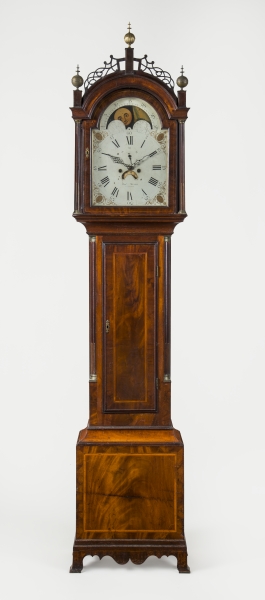
FIG. 5. Eight-day clock, Daniel Munroe (1775–1859), case attributed to William Munroe, Concord, ca. 1800. Mahogany, cherry, pine, iron, brass, steel; h 89, w 20⅞, d 10⅜. Concord Museum; Anonymous Gift; Gift of the Cummings Davis Society (1995) (1995.017). Photo, Gavin Ashworth.
The clock survives in remarkably good condition, having remained in the Merriam house in Concord until 1856 and then moving only once or twice before entering the collection of the Concord Museum. The workmanship is everywhere precise and detailed (fig. 6). The veneers and crossbandings are carefully chosen and placed, with especially fiery-grained pieces chosen for the plinths below the quarter columns flanking the waist door.20 The line inlays are razor thin; a stack of two light lines and one dark on the waist door is only two millimeters wide.21
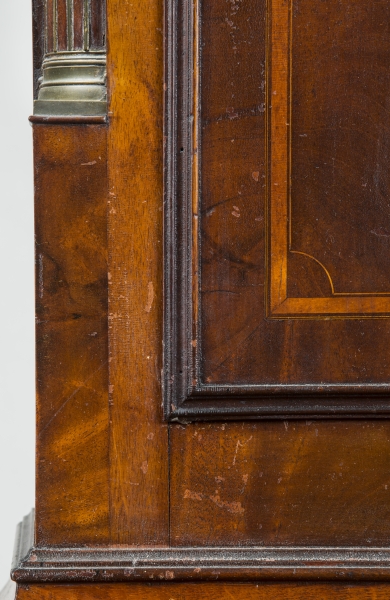
FIG. 6. Lower waist and door of the clock in fig. 5. Photo, Gavin Ashworth.
Munroe’s neat workmanship is evident inside as well. The interior is unstained, in contrast to the usual practice in Roxbury, and he employed a complicated glue blocking system throughout. For the corners of the waist, the four-piece assemblage runs the full length of the waist, with the principal quarter round composed of one long piece, cut almost through at intervals with a saw kerf (fig. 7).22 The glue blocking of the feet is formed by one element rabbeted into another, and the angled flare of the French feet is matched by the angled cuts of just a few degrees in the vertical glue blocks (fig. 8). This same glue blocking system is evident in the feet of a Nathaniel Munroe shelf clock in the collection of Yale University and in a chest that William made for his own use (fig. 9).23 The same bracing method can also be found along the waist of a Simon Willard eight-day clock in the collection of the Massachusetts Historical Society.24 That case resembles Munroe’s in other details as well, such as the strongly figured veneers on the waist column plinths, but it is not his workmanship. Who, then, made it? Could it have been Munroe and Clap? The question is complicated by the consideration that the foot blocking and related blocking in the waist are characteristic of furniture associated with Thomas Seymour as well.25
FIG. 7. In this detail of the clock in fig. 5, the hood has been removed and the viewer is looking down on the top of the saddle board in the foreground and the top of the case molding on which the hood rests in the background. A “four-piece assemblage” of support blocks can be seen in the upper left corner of the case. Photo, Gavin Ashworth.
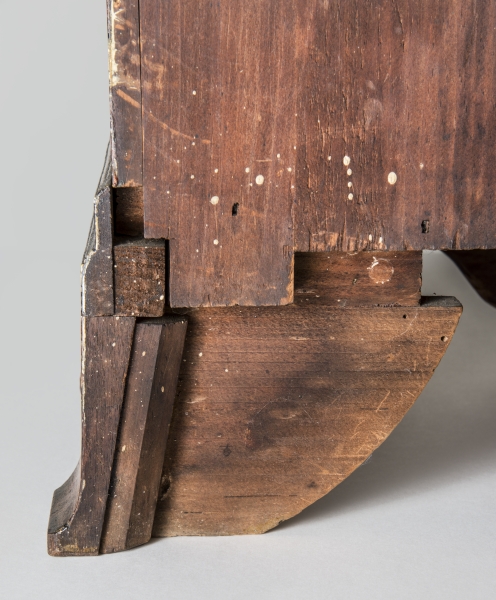
FIG. 8. Glue blocking of the clock in fig. 5. Photo, Gavin Ashworth.
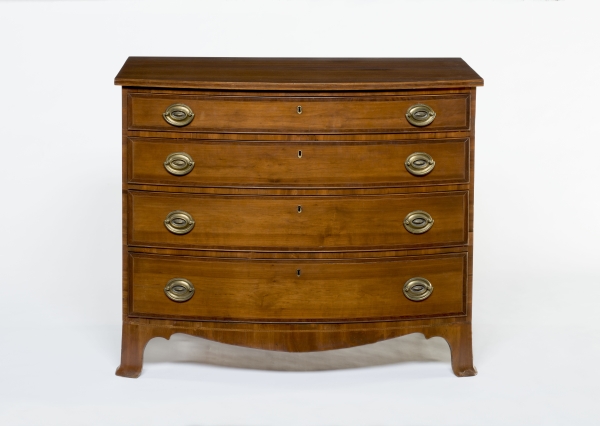
FIG. 9. Chest of drawers, attributed to William Munroe, Concord, ca. 1805. Cherry, cherry veneer, white pine; h 31½, w 38½, d 21. Private collection. Photo, David Bohl.
During June 1800 to July 1802, in addition to eight-day clock cases, William made timepiece cases for both his brothers, Daniel and Nathaniel. Two kinds of timepieces are associated with the Munroe clockmakers. The first is in the form known as a Massachusetts shelf clock; several of these survive with the distinctive scrolled base and flared French feet (fig. 10).26 The other timepieces associated with those by the Munroes more closely resemble Willard’s patent timepiece, though with a lozenge-shaped head rather than a circular one (fig. 11). About a dozen of these distinctive timepieces, known to collectors as “diamond-head banjos,” survive in various public and private collections. Munroe charged $3, $3.50, and $6 for timepiece cases made for his brothers in 1801. The cost discrepancy suggests that he was in fact making two different forms, with the $6 cases more likely the Massachusetts shelf clock form.27
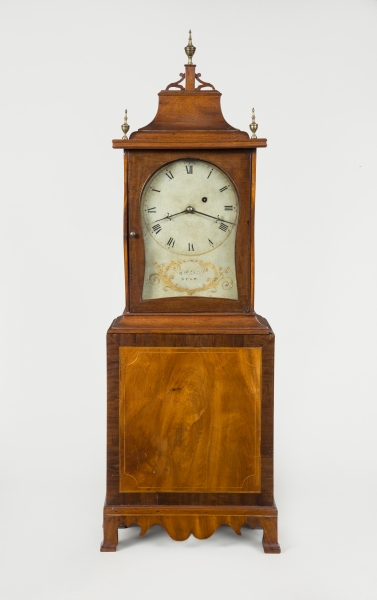
FIG. 10. Shelf clock, Asaph Whitcomb (1786–1821), Stow, Massachusetts, ca. 1810. Mahogany, mahogany veneer, white pine, brass, steel, painted iron; h without finial 36½, w 13¾, d 6¾. Concord Museum; Anonymous Gift; Anonymous Gift; Anonymous Gift; Gift of the Cummings Davis Society (2003.015). Photo, Gavin Ashworth.
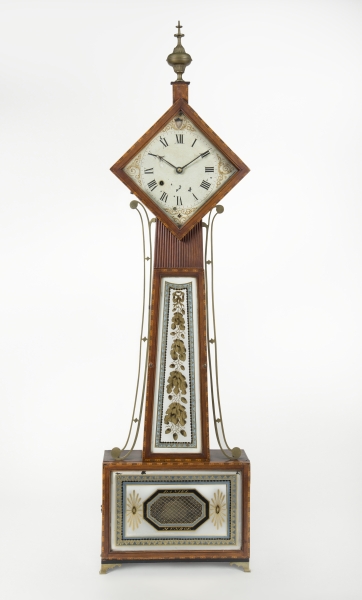
FIG. 11. Timepiece, Daniel Munroe, case attributed to William Munroe, Concord, 1800–1801. Mahogany, mahogany veneer, inlay of various woods, brass, steel, painted iron, painted glass; h 40½, w 12, d 4¼. Concord Museum; Anonymous Gift (1998.002). Photo, Gavin Ashworth.
The Daniel Munroe timepiece in the Concord Museum (see fig. 11) is perhaps in the best condition of all the known examples of the diamond-head form, having retained all its original elements (except the finial); the glasses and dial are essentially intact and unrestored, and the finish is old. As in the Merriam clock case, the workmanship is detailed and precise. The head and base are both blind-dovetailed boxes, and the doors are both dovetailed and mitered at the corners. This workmanship is sometimes seen among the earliest Willard patent timepieces.28 The reverse-painted glasses, product of an unidentified Roxbury or Boston shop, are also early, characteristic of those found on the earliest Willard patent timepieces. A detail not found on Willard timepieces is the inlay that highlights the edges (fig. 12). Originally colored red, white, and blue, this complicated ornament has been found on no form other than these timepieces.29
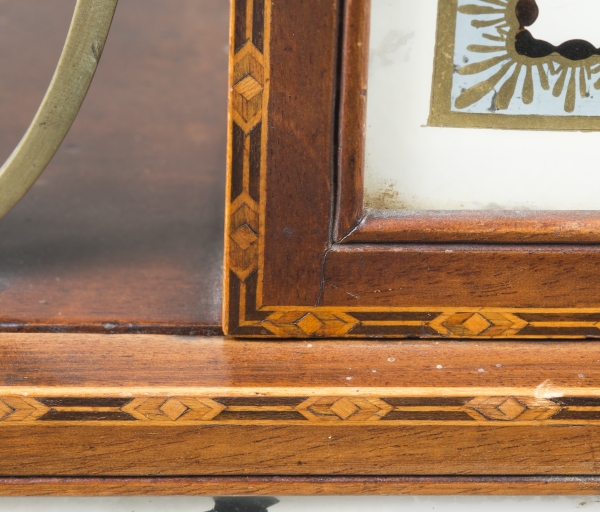
FIG. 12. Inlay of the timepiece in fig. 11. Photo, Gavin Ashworth.
These diamond-head timepieces are difficult to interpret. The lozenge shape and the inverted movement have been interpreted as attempts to circumvent Simon Willard’s 1802 patent, but there is reason to believe that the example in the Concord Museum collection predates that patent (see fig. 11).30 In addition to variations among the Munroe diamond-head examples, a distinctively different version seems to have been made in Boston. Represented by at least three examples (one at Winterthur Museum, one in the Concord Museum, and one in a private collection), this variant has a mahogany rather than a glass waist panel. This group also shares details with the earliest Willard patent timepieces; the glass and the dial of the Winterthur example, for instance, closely resemble those on the Daniel Munroe example and must be nearly contemporaneous.31
Apart from stylistically datable features—which, given the paucity of secure documentation on earlier timepieces, are only approximate—another reason for assigning the Daniel Munroe timepiece a date before 1802 is that William changed his mode of business that year. “In July 1802 I was taken in as a partner with my Brothers, and we endeavored to drive business. . . . We continued as partners until July 1804.” The label of Daniel and Nathaniel Munroe, which was used on Daniel Munroe and Company clocks, reveals some of the means they used to drive business (fig. 13). Clocks were offered for sale by the dozen at a reduced price and could be boxed and delivered free to any port within thirty miles of Concord. The thirty-mile radius encompasses most of Massachusetts Bay; Boston is nineteen miles east of Concord, Salem just under thirty miles to the north, and Quincy just over thirty miles to the south.
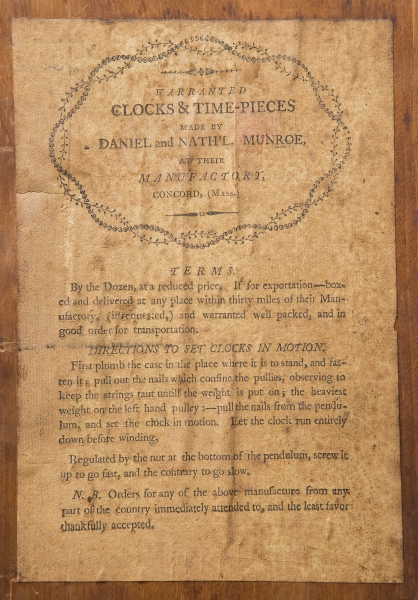
FIG. 13. Label of Daniel and Nathaniel Munroe (1777–1861) on an eight-day clock. Private collection. Photo, Robert Cheney.
William Munroe’s account books record only minor charges entered when the partnership ended; the accounts for Daniel Munroe and Company were probably kept by Daniel. It is not yet possible to estimate the number of clocks and timepieces made by the firm, but if William Munroe was fully employed during that period, they would certainly number in the hundreds. Parts for the movements were cast at Nathaniel Munroe’s brass foundry across the Milldam from his clock shop and were finished by his journeyman clockmaker, Samuel Platt, who also lived on the Milldam.
The clocks of Daniel Munroe and Company are of very high quality. The workmanship of the cases hardly varies from that seen in the Merriam clock, with the exception of the base. Instead of flared French feet with complicated blocking, the eight-day clocks have ogee bracket feet. Similarly, the one diamond-head timepiece known from Daniel Munroe and Company is slightly simplified; the complicated polychrome inlay is absent.32
A clock in a private collection is inscribed “Nath’l Munroe” on the dial (fig. 14). This clock also has the printed paper label like the one in figure 13, and the punch mark “WM,” indicating William Munroe (fig. 15). Although inscribed with Nathaniel’s name alone, the label and punch mark indicate that this is a product of the 1802-4 partnership of the three Munroes.33 Such marks, usually referred to as journeyman’s marks, are found infrequently on Massachusetts federal furniture. The exception is the shop of Stephen Badlam, where Munroe trained for almost a year. A tray in the Concord Museum collection bears the impressed mark “S.BADLAM” along with the two-initial mark of Abiel White. White also trained in Badlam’s shop, and his mark on the tray is interpreted as a journeyman’s mark.34 In 1800, Munroe bought a “stamp” for a fairly substantial 75 cents from L. Little, which may have been the one used to make this mark. Another important feature shared by William Munroe and Abiel White clocks is that both makers cut a tiny paring out of the upper right-hand corner of the waist door surround. This was done to allow clearance for the molding surrounding the door when the door was opened, apparently because the hinges were set back a bit. To date, only cases by White and Munroe are known to have this idiosyncratic detail.35
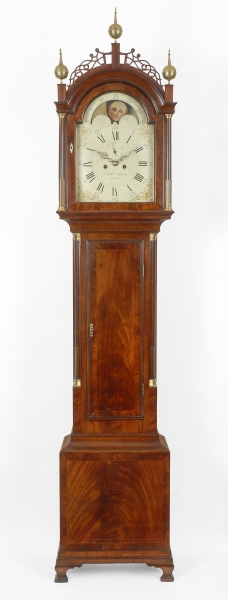
FIG. 14. Eight-day clock, Nathaniel Munroe and William Munroe, Concord, 1802–4. Mahogany, mahogany veneer, pine, iron, paint, brass; h 96⅜, w 20¼, d 10¼. Private collection. Photo, Gary R. Sullivan Antiques Inc.
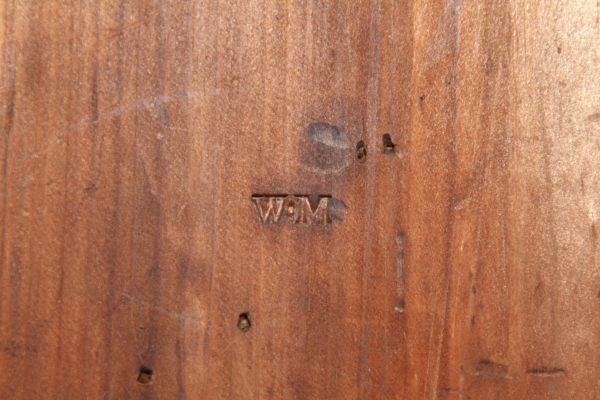
FIG. 15. The mark on an eight-day clock, D. Munroe & Co., Concord, 1802–4. Mahogany, mahogany veneer, pine, iron, paint, brass; h 89, w 20¼, d 10. Concord Museum; Gift of the Cummings Davis Society; Gift of Joseph and Ann Pellegrino; Gift of Peter and Anne Brooke; Gift of Seymour and Paula DiMare (2005.002).
A clock in a private collection bearing the printed label and Munroe’s mark is inscribed “Nathaniel Munroe” on the dial, but this clock is probably correctly interpreted as a product of the 1802–4 partnership. The three brothers seem to have used the clocks and timepieces they made as a sort of barter currency to balance the firm’s accounts. In the fall of 1804, two months after the partnership ended, William Munroe took ten “handsome” timepieces to Philadelphia, perhaps diamond-head timepieces, “because I could not collect money due to me from my [brother Daniel].” Nathaniel Munroe may also have taken some finished clocks as payment from the firm and had his name put on the dial; in 1805, he advertised clocks “direct from his manufactory” for sale in Norfolk, Virginia.36
No clock case from the period of the partnership has yet been identified as the work of any of the Munroe cabinetmakers other than William.37 Given that the presumed function of the mark was to distinguish the work of one worker from the otherwise identical work of another, so that each may get proper pay, why Munroe used the mark at all is unclear, nor is it clear why only some cases bear it.
After the breakup of the partnership in 1804, William continued to work as a cabinetmaker, making a wide variety of objects: clock and timepiece cases, gun stocks, halberd poles, picture frames, cradles, bedsteads, card tables and dining tables, candle stands, profile frames, Pembroke tables, bureaus, trade signs for his brothers Nathaniel, Daniel, and John (this last’s in the form of a watch), coffins for adults and children, a martin house, pistol stocks, parasol sticks, gauge sticks, rules and want sticks, a desk and bookcase, a pine desk with drawers, and a crutch.
It was probably during this period that William Munroe made a chest of four drawers that remains in the family (see fig. 9). The blocking of the flared French feet matches that found on the Merriam clock (see fig. 7). Munroe sold a bureau to Boston auctioneers Charles Nolen and William Gridley in 1811 for $28, which may have been like this one. But by 1812, “finding that I could not dispose of so much furniture as I could make with my own hands, Business of every kind extremely bad; Clocks fast going out of fashion, My family expences at the same time increasing, etc., I found that unless I could start some project whereby I could earn money faster—I should, in a few years at most, even if I should have my health, be poor.” Munroe did make the furniture with his own hands—his shop in Concord was the inverse of Deacon Nehemiah Munroe’s—for William trained no apprentices and employed no journeymen.
Munroe tried various projects, including growing teasels for the woolen mills, making toothbrushes and watch brushes (complaining in 1839 that some of the latter were still in the house), and then pencils (fig. 16). The war had interrupted the supply of these writing implements from England, and Munroe took advantage of the shortage with immediate success. Although he had trouble finding graphite and cedar, he was soon contracting to make pencils by the thousand. He expected the opportunity to evaporate with the end of the war, but it continued and he prospered. He went from an income of $700 a year to $7,000, and he never turned back—with one interesting exception.
In 1816, Munroe interrupted his pencil production. On a page in his account book labeled “No. 2” is this note:
June 12 1816 Bargained with Nath’l Munroe & Lem’l Curtis to deliver them one hundred timepiece cases & boxes to be delivered as soon as convenient at $3:50 each—they are to pay me four timepieces complete with boxes at $27/50 for gilt doors & 25:00 for plain to be paid on demand the other payment to be on the delivery of the cases, say half down & half in six months with interest Also—Bargained with Eben’r Wood to make me one hundred & fifty timepiece Cases & boxes & am to pay him therefore $1.25 each, he agrees to take one timepiece as part pay & all preparations to make the cases is considered in the bargain as my property.
“Boxes” refers to simple trapezoidal pine shipping boxes, which, if charged separately, cost 30 cents. Munroe was making $2.25 on every case and box he supplied.38
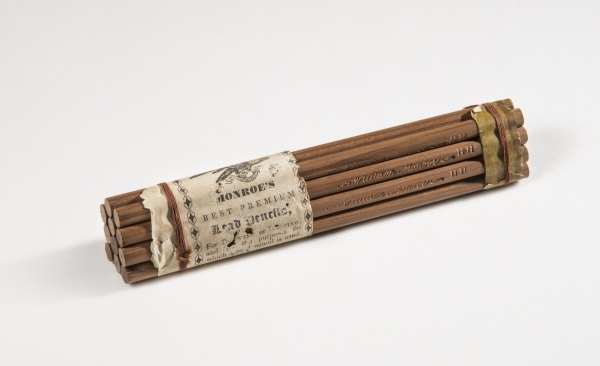
FIG. 16. Bundle of pencils, William Munroe shop, Concord, ca. 1840. Cedar, graphite, letterpress ink on paper; l 6½. Concord Museum; Gift of Mr. Charles P. Munroe and Mr. William M. Munroe (2007.261.0022). Photo, Gavin Ashworth.
The expiration of Simon Willard’s timepiece patent in 1816 seems to have inspired the Concord makers to ramp up production of timepieces. Munroe made thirty timepiece cases in 1807 but for most years from 1804 to 1816 he made none at all: however, between 1816 and 1819 his journeymen, Ebenezer Wood and after 1816 James Adams, produced two or three hundred a year. In this period, Munroe at last came to head a shop he didn’t work in.
Scholars have long noted that, no matter whose name is on the dial, Concord timepiece cases are all alike (fig. 17).39 One distinctive feature of these timepieces is the shaping of the inside of the head (fig. 18). Examples from Boston and Roxbury tend to have parallel sides, which wastes wood; by contrast, in Concord timepieces, the interior cut of one piece forms the exterior surface of the next, with little waste. The glue blocking is neat, each block is chamfered and consistently placed, and, as with the eight-day clock cases, the interior is unstained. The backboard also conserves wood, with its trapezoidal central element pieced out on the sides of the head and base. The reason Concord cases are so consistent is now clear: they were all made in William Munroe’s shop.
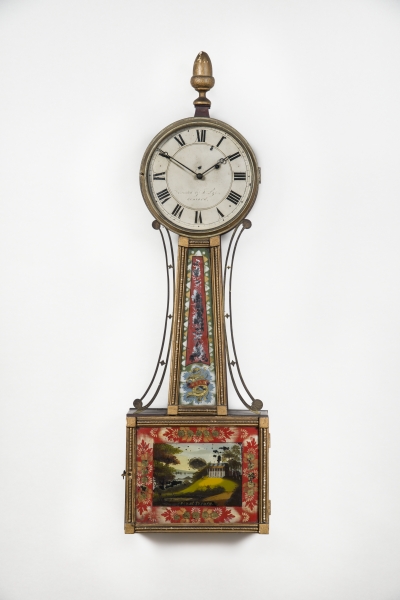
FIG. 17. Timepiece, Joseph Dyar (1795–1851), case attributed to Ebenezer Wood (1792–1880) or James Adams (1796–1863) working in the William Munroe shop, Concord, 1816–19. Mahogany, gilt pine, painted glass, brass, steel, painted iron; h 33½, w 10, d 3¾. Concord Museum; Gift of Joseph and Anne Pellegrino (F2530). Photo, Gavin Ashworth.
FIG. 18. Interior of the timepiece in fig. 17. Photo, Gavin Ashworth.
In 1819, Concord’s spate of patent timepiecemaking ended, at least as far as William Munroe was concerned. No charges for timepiece cases are recorded in his accounts after April of that year. Nathaniel Munroe had gone to Baltimore in 1817, and in 1821 and 1822 Lemuel Curtis and Joseph Dyar went to Vermont. Why the trade broke up is unclear. Some evidence suggests that the patent timepiece was going out of fashion, declining steadily in retail price from $35 to $25, but the economic correction of 1818 may have depressed the market for all luxury goods, including these fancy timepieces. In any event, William Munroe found a market for his pencils and stable sources of graphite and cedar with which to make them. He continued to produce pencils wholesale, entirely with journeyman labor from Ebenezer Wood, James Adams, and several others, including some indigent Boston cabinetmakers. By 1839 he had $20,000 in the bank. William Munroe was a good citizen of Concord, about as well connected as anyone could be. As a member of the Social Circle, he dined twenty-five times a year with the likes of minister Ezra Ripley, Revolutionary War veteran and cabinetmaker Joseph Hosmer, and philosopher Ralph Waldo Emerson. He was a member of the First Parish, the Fire Society, and the Concord Light Infantry and became an investor in the banks and the insurance company that had essentially replaced manufacturing on the Milldam. The best workman in the shop had left the bench.

1. Humberto R. Maturana and Francisco J. Varela, Autopoiesis and Cognition: The Realization of the Living, Boston Studies in the Philosophy of Science, vol. 42 (Boston: D. Reidel, 1980), 78.
2. William Munroe, autographical sketch (1839), Concord Museum, Concord, Mass. (2007.261.196–97). Munroe’s autobiography is in two volumes of seventeen leaves each. These volumes are part of the more than four hundred documents and artifacts that were the generous gift to the Concord Museum by William Munroe’s great-great-grandchildren Bill and Charlie Munroe in 2009.
3. I am grateful to Judy Fichtenbaum for numerous details of Munroe’s genealogy. Paul Foley’s Willard’s Patent Time Pieces (Norwell, Mass.: Roxbury Village, 2002), particularly in its biographical notes on workers involved in the Boston-area clock trade, provides a detailed image of Roxbury’s craft community in the late eighteenth and early nineteenth centuries.
4. Unless otherwise noted, all quotations are from William Munroe’s autobiography.
5. For Stephen Badlam’s shop, see Gerald W. R. Ward, American Case Furniture in the Mabel Brady Garvan and Other Collections at Yale University (New Haven: Yale University Art Gallery, 1988), 171–77; and Derin Tyler Bray, “Urban Craft in Rural Massachusetts: The Weymouth Cabinetmaking Shop of Abiel White, 1790–1851” (master’s thesis, University of Delaware, 2006). Also useful is Mabel Munson Swan, “General Stephen Badlam—Cabinet and Looking-Glass Maker,” Antiques 65, no. 5 (May 1954): 380–383.
6. For example, an eight-day clock with dial inscribed “Aaron Willard” and case marked “S.BADLAM” and “I.C” in the Willard House and Clock Museum; see Roger W. Robinson and Herschel B. Burt, The Willard House and Clock Museum (Columbia, Pa.: National Association of Watch and Clock Collectors, 1996), 88.
7. William Munroe’s name does not appear among the apprentices Stephen Badlam listed in his journal; Robert Mussey, personal communication.
8. Brock Jobe, Gary R. Sullivan, and Jack O’Brien, Harbor and Home: Furniture of Southeastern Massachusetts, 1710–1850 (Lebanon, N.H.: University Press of New England, 2009), 22. Paul Foley, in Willard’s Patent Time Pieces, found no record of John Padelford working in Roxbury.
9. Foley, Willard’s Patent Time Pieces, 289.
10. Ibid., 287.
11. Kemble Widmer and Joyce King, et al., In Plain Sight: Discovering the Furniture of Nathaniel Gould (Salem: Peabody Essex Museum in association with D. Giles, London, 2014) is filled with insights into the structure of an urban Massachusetts cabinetmaking shop active from about 1760 to 1780. Like Stephen Badlam and Nehemiah Munroe a generation later, and unlike the majority of Massachusetts cabinetmakers, Nathaniel Gould was very successful financially. The list of thirty-seven cabinetmakers who provided Gould with products or labor (appendix B) suggests strongly that Gould’s success was, like that of Badlam and Munroe, at least in part a function of his detachment from the bench.
12. Foley, Willard’s Patent Time Pieces, 229, 323, 297. An armchair with Lemuel Churchill’s label is in the Winterthur collection; see Charles F. Montgomery, American Furniture: The Federal Period (New York: Viking Press, 1966), cat. no. 116. William Munroe documented Ephraim Capen’s work as a journeyman in his autobiography.
13. Clockmaker Nathaniel Munroe’s 1812 contract with Joseph Cone Jr. stipulated that Munroe would “provide unto the said Apprentice suitable food, drink, lodging, clothing, medicine & nursing in sickness, and at the expiration of said term will furnish said Joseph junior one suit of clothes suitable for a working dress, and one handsome suit to be worn on other occasions”; apprenticeship contract, Nehemiah Munroe to Joseph Cone Jr., 1812, William Munroe Special Collections, Concord Free Public Library. The earliest entries in William Munroe’s first account book, dated December 1799, are for linen, broadcloth, silk twist, buttons, and similar items and may represent the suit or suits he received at the end of his apprenticeship.
14. See Robert D. Mussey Jr., The Furniture Masterworks of John and Thomas Seymour (Salem: Peabody Essex Museum, 2003), cat. no. 34.
15. David F. Wood, “William Munroe’s ‘Baby Sideboard Model,’” Antiques and Fine Art 13, no. 3 (Autumn 2014): 154–57.
16. William Munroe, account book no. 1, Concord Museum (2009.4.1). Two years later, in 1801, the Articles of the Salem Cabinet-Maker Society listed $18 for the making of a sash-cornered sideboard with a $60 retail price (p. 9). The articles list $4 for the making of a sash-cornered card table (p. 14) and $2 for a fire screen (p. 16), forms for which Munroe received $4.67 and $3, respectively. The differential might indicate a contraction of prices in the intervening two years or perhaps just reflects a cost-of-living difference between Boston and Salem; see Dean Thomas Lahikainen, “A Salem Cabinetmakers’ Price Book,” in American Furniture 2001, ed. Luke Beckerdite (Milwaukee, Wis.: Chipstone Foundation, 2001), 152–219.
17. The map is illustrated and discussed in David F. Wood, “Concord, Massachusetts, Clockmakers, 1789–1817,” Antiques 157, no. 5 (May 2000): 760–69.
18. The 1801 Salem price book lists $9 for the making of a mahogany clock case; see Lahikainen, “A Salem Cabinetmakers’ Price Book,” 209.
19. “My mother was telling to-night of the sounds which she used to hear summer nights when she was young and lived on the Virginia road,—the lowing of cows, or cackling of geese. Or the beating of a drum as far off as Hildreth’s, but above all Joe Merriam whistling to his team, for he was an admirable whistler.” See The Journal of Henry Thoreau Volume IX (Salt Lake City, Utah: Peregrine Smith, 1984), 381 (May 26, 1857).
20. John Delaney Jr. has suggested that this degree of care in the use of vibrant veneers is unusual even among the best Roxbury cases but is a regular feature of cases out of Stephen Badlam’s shop; personal communication.
21. An October 1801 entry against Daniel Munroe in William Munroe’s account book reads: “To black wood couler’d at Williams’s.” The charge was 33 cents.
22. According to Robert Mussey, this rather complicated glue blocking system is the same as that found in the waists of eight-day clock cases that can be attributed to Thomas Seymour; personal communication.
23. Edwin A. Battison and Patricia E. Kane, The American Clock, 1725–1865: The Mabel Brady Garvan and Other Collections at Yale University (Greenwich, Conn.: New York Graphic Society, 1973), 172–73.
24. Massachusetts Historical Society, Boston (1037).
25. Mussey, John and Thomas Seymour, 129.
26. A shelf clock seemingly identical to the Nathaniel Munroe example at Yale sold at Skinner on May 3, 2014, lot 497. The dial is inscribed “John Munroe / Barnstable.” The case is almost certainly by William Munroe, and the movement most likely by Nathaniel Munroe. For John Munroe, see Wood, “Concord, Massachusetts, Clockmakers”; and Foley, Willard’s Patent Time Pieces. Two shelf clocks inscribed “Joshua Wilder” on the dial, one at Old Sturbridge Village (Philip Zea and Robert C. Cheney, Clock Making in New England, 1725–1825: An Interpretation of the Old Sturbridge Village Collection, ed. Caroline F. Sloat [Sturbridge, Mass.: Old Sturbridge Village, 1992], 104) and one in a private collection (Skinner, Nov. 7, 2004, lot 131), are in cases that are closely related to the case at Yale. No sales to Wilder are recorded in William Munroe’s accounts. In addition, two shelf clocks by Asaph Whitcomb of Stow, Mass., one in the Concord Museum collection (see fig. 10), are in cases that are of the same design as the Yale timepiece but are not made by William Munroe. More investigation of this interesting group of cases should clarify the relationships between them.
27. The $6 timepiece cases were made for Nathaniel. Only one diamond-head associated with Nathaniel Munroe (inscribed “Munrow / Concord” on the waist glass) is known (Old Sturbridge Village; Zea and Cheney, Clock Making in New England, 70), and it is later; the naval episode from the War of 1812 depicted in the lower glass suggests a date of about 1815. It differs in detail from the Concord Museum example, and the case was probably not made by William.
28. See, for instance, the example at the American Clock and Watch Museum; Foley, Willard’s Patent Time Pieces, 7.
29. Cabinetmaker Michael P. Wheeler of Boston has convincingly reproduced this inlay in its original vivid coloration.
30. Zea and Cheney, Clock Making in New England, 70.
31. For the Winterthur example, see Montgomery, American Furniture, 206; and Philip Zea, “Clockmaking and Society at the River and the Bay: Jedediah and Jabez Baldwin, 1790–1820,” in The Bay and the River: 1600–1900, The Dublin Seminar for New England Folklife Annual Proceedings, 1976 (Boston: Boston University, 1982), 55–56, n. 33.
32. This example was sold by Gary Sullivan Antiques, Sharon, Mass., in 2009.
33. The mark is also found on a clock in the Old Sturbridge Village collection, illustrated in Zea and Cheney, Clock Making in New England, 69. Other examples of eight-day clocks with the printed paper label of Nathaniel and Daniel Munroe and the “W.M” punch mark of William Munroe, variously inscribed Nathaniel Munroe, Daniel Munroe, or William Munroe & Co., are in private collections.
34. A Simon Willard eight-day clock in the Willard House Museum (Robinson and Burt, Willard House and Clock Museum, 88) is marked “I.C,” possibly for John Crehore, another Badlam journeyman. I am grateful to Robert Mussey for the attribution of the initials to Crehore.
35. I am grateful to Gary Sullivan for this observation on Abiel White’s practice.
36. Wood, “Concord, Massachusetts, Clockmakers,” 763.
37. A Daniel Munroe eight-day clock with a case that can plausibly be attributed to Ammi White of Concord is in a private collection. This clock presumably dates from 1798 to 1800, before William arrived in Concord.
38. William Munroe, account book 2, Concord Museum (2007.26.1). Widmer and King find that Nathaniel Gould maintained a ratio of a little over 2 to 1 between what he paid a journeyman and what he charged a customer for a piece of furniture in the 1760s; In Plain Sight, 116–17, 147–48. A ratio of about 3 to 1 is indicated by the Salem price book of 1801; Lahikainen, “A Salem Cabinetmakers’ Price Book.”
39. On Concord timepieces in general, see Foley, Willard’s Patent Timepieces; Zea and Cheney, Clock Making in New England, 69–72; and Wood, “Concord, Massachusetts, Clockmakers.”

